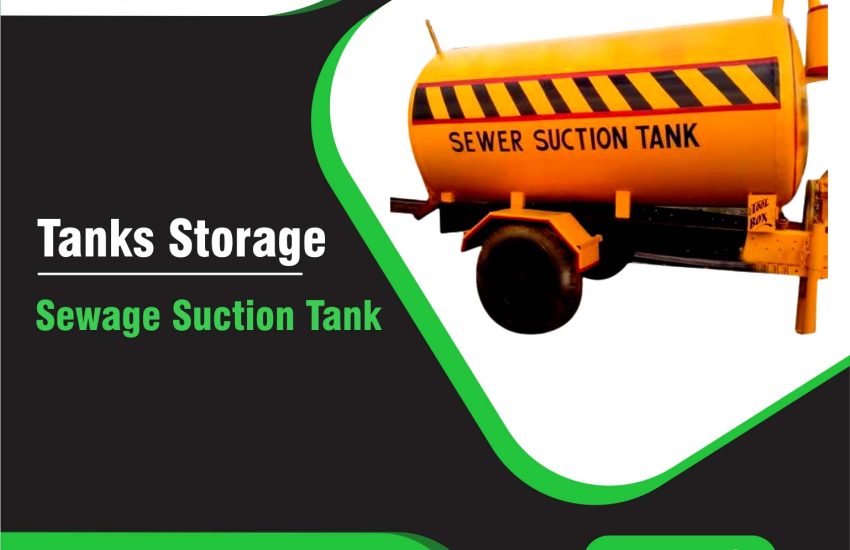Sewage Suction Tank plays a crucial role in maintaining cleanliness in various sectors. This equipment helps efficiently collect and transport sewage waste, ensuring a sanitary and odor-free environment. In this article, we’ll explore the specifications, features, and benefits of a sewage suction tank, focusing on important SEO keywords.
What is a Sewage Suction Tank?
A sewage suction tank collects, stores, and transports liquid waste such as sewage and sludge. These tanks, mounted on vacuum trucks or sewage pumping vehicles, help remove waste from septic systems, sewage pits, and wastewater treatment plants.
Key Specifications of Sewage Suction Tanks
- Capacity: Sewage suction tanks come in various sizes, ranging from 500 liters to 12,000 liters. Smaller models work for residential and commercial use, while larger tanks serve industrial and municipal applications.
- Material: Manufacturers make sewage suction tanks from stainless steel, Mild Steel (MS), or fiberglass-reinforced plastic (FRP). These materials ensure the tanks’ durability and resistance to corrosion, making them suitable for tough environments.
- Pump Type: The tank uses a vacuum pump to create suction and remove waste. The most common types of pumps are rotary vane pumps, diaphragm pumps, and piston pumps.
- Pressure Rating: Sewage suction tanks have a pressure rating typically ranging from 10 bar to 25 bar. A higher pressure rating allows for better suction and faster waste removal.
- Suction Hose: The tank features a reinforced rubber or PVC suction hose, usually between 10 meters to 50 meters. The hose length depends on the system’s needs and intended use.
- Filtration System: Many tanks include a filtration system or strainer to filter out debris before waste enters the tank. This improves waste handling efficiency.
- Discharge System: The discharge system uses a rotary valve or ball valve to release collected waste into treatment facilities or disposal sites.
- Safety Features: Sewage suction tanks come with overflow valves, ventilation systems, and pressure relief valves that ensure the system operates safely and prevent contamination.
Key Features of Sewage Suction Tanks
- Durability: Sewage suction tanks withstand harsh environments thanks to their corrosion-resistant materials. This durability reduces maintenance needs over time.
- Efficient Waste Collection: The powerful suction system allows the tank to quickly and efficiently collect waste. The vacuum function helps remove waste from septic tanks and sewage systems with ease.
- Portability: Mounted on trucks, sewage suction tanks are mobile. This feature allows them to reach remote or difficult-to-access locations for waste removal.
- Eco-friendly Design: Modern sewage suction tanks are designed to be environmentally friendly. Features like leak-proof construction and effective filtration minimize the risk of environmental contamination.
- Easy Maintenance: The tanks are designed for easy cleaning and maintenance. The filtration systems are easy to remove, ensuring regular maintenance is simple.
- Cost-Effectiveness: While the initial investment may be high, sewage suction tanks reduce operational costs in the long term by improving efficiency and eliminating labor-intensive waste removal methods.
Applications of Sewage Suction Tanks
Sewage suction tanks are used across many industries:
- Residential and Commercial Use: These tanks remove sewage from septic systems and perform drain cleaning in homes and businesses.
- Municipal Use: Sewage suction tanks play a key role in maintaining large-scale sewage systems in cities and towns.
- Industrial Use: Industries use these tanks to remove waste, sludge, and other liquid by-products from factories and plants.
- Agricultural Use: Farms use these tanks to manage waste in manure pits and silage storage.
Benefits of Sewage Suction Tanks
- Improved Hygiene: Regular use of sewage suction tanks prevents waste buildup in septic tanks and sewage systems, ensuring cleaner and healthier environments.
- Time-Saving: The suction system allows for quick waste removal, reducing downtime and ensuring operations are completed within the required timeframe.
- Cost Efficiency: Although they require a significant upfront investment, sewage suction tanks save money over time by reducing labor costs and improving waste removal efficiency.
- Environmental Safety: With proper waste management, sewage suction tanks prevent pollution and environmental contamination, ensuring safe disposal of sewage.
Conclusion
A sewage suction tank is an indispensable tool for managing waste efficiently and safely. Whether used for residential, commercial, industrial, or municipal purposes, it provides a reliable and cost-effective waste removal solution. With durable materials, powerful suction systems, and eco-friendly features, these tanks are essential for effective waste management.


